Over the weekend, Rosetta experienced a ‘safe mode’ event 5 km from the surface of Comet 67P/Churyumov-Gerasimenko. Contact with the spacecraft has since been recovered and the mission teams are working to resume normal operations.
“We lost contact with the spacecraft on Saturday evening for nearly 24 hours,” says Patrick Martin, ESA’s Rosetta mission manager. “Preliminary analysis by our flight dynamics team suggests that the star trackers locked on to a false star – that is, they were confused by comet dust close to the comet, as has been experienced before in the mission.”
This led to spacecraft pointing errors, which triggered the safe mode. Unfortunately the star trackers then got hung in a particular sub mode requiring specific action from Earth to recover the spacecraft.
“It was an extremely dramatic weekend,” says Sylvain Lodiot, ESA’s Rosetta spacecraft operations manager.
“After we lost contact, we sent commands ‘in the blind’, which successfully tackled the hung star tracker issue and brought the spacecraft back into three-axis stabilised safe mode, and we now have contact with the spacecraft again. However, we are still trying to confirm the spacecraft’s exact position along its orbit around the comet – we only received images for navigation this morning, the first since Saturday.”
As is normal during an event like this, extra ground tracking station time was requested to provide additional support for recovering the spacecraft. The regularly scheduled Rosetta tracking slot using ESA’s New Norcia deep space station in Australia on Sunday was extended, with time reallocated from Mars Express operations. The blind commanding was done from New Norcia, and later, ESA’s Cebreros deep space station in Spain was also used to support the recovery.
Rosetta’s star trackers are marked here in red (above Philae in this pre-seperation artist impression). Part of the high gain antenna can be seen in the background. Image credit: ESA/ATG medialab.
Star tracker recap
The spacecraft’s star trackers are used to navigate, and help control the attitude of the spacecraft. By using an autonomous star pattern recognition function, they provide input to the onboard Attitude and Orbit Control and Measurement Subsystem used to maintain the spacecraft’s orientation with respect to the stars. This allows the spacecraft to know its orientation with respect to the Sun and Earth. In turn, this ensures the spacecraft can correctly orient its high gain antenna, used to send and receive signals to and from ground stations on Earth.
Correct attitude is maintained when the star trackers are properly tracking stars. If this is interrupted, the spacecraft’s antenna can drift away from Earth and communication with the spacecraft potentially lost. When the star trackers are not tracking, the attitude is propagated on gyro measurements. But the attitude can drift, especially if the spacecraft is slewing a lot.
Operating close to the comet means that the spacecraft is surrounded by a lot of dust. Even though the comet’s activity has diminished significantly since passing through its closest point to the Sun along its orbit last August, the environment is still dusty enough that the star trackers can occasionally mistake comet debris in its field of view for stars.
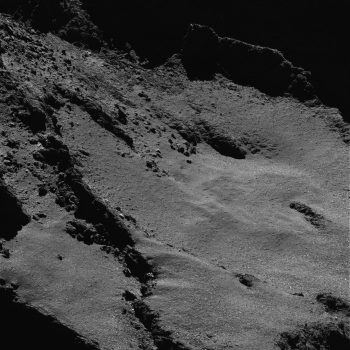
OSIRIS narrow-angle camera image taken in the morning of 28 May 2016 (many hours before the safe mode) when Rosetta was 7.05 km from the centre of Comet 67P/Churyumov–Gerasimenko. The scale is 0.13 m/pixel. Credits: ESA/Rosetta/MPS for OSIRIS Team MPS/UPD/LAM/IAA/SSO/INTA/UPM/DASP/IDA
What happens next?
As usual with a safe mode, the science instruments are automatically switched off, allowing the spacecraft operators to take the necessary steps to fully recover the spacecraft before resuming science operations. Prior to the safe mode, the plan for this week was to move into 30 km orbits around the comet on Wednesday 1 June. The team still hopes to meet this target and be able to resume normal operations by then.
Update 2 June: The transition to the 30 km orbit started as planned, yesterday morning, with an orbital correction manoeuvre to bring Rosetta to 30 km by late Friday night (the orbit insertion manoeuvre is planned for 01:40 UTC Saturday). The spacecraft’s instruments are also now back in science operations mode.
The challenges ahead
The dramatic events of the weekend are a stark reminder of the dangers associated with flying close to the comet, and highlights the risks the spacecraft will face during the final few weeks of the mission as it descends even closer to the comet.
“The last six weeks of the mission will be far more challenging for flight dynamics than deploying Philae to the surface was in November 2014, and it is always possible that we could get another safe mode when flying close to the comet like this,” says Sylvain.
“Although we will take more risks nearer to the end of the mission, we’ll always put the spacecraft safety first.
“However, the very final sequence where Rosetta makes a controlled impact on the surface of the comet should not be affected by such star tracker issues as we plan to take them out of the attitude and orbit control system loop.”
The team will also consider taking the star trackers out of the loop when required in the last weeks of the mission.
Details of Rosetta’s final descent will be provided soon. The provisional plan is to target the small lobe close to Philae’s original planned landing site at Agilkia, most likely on 30 September.

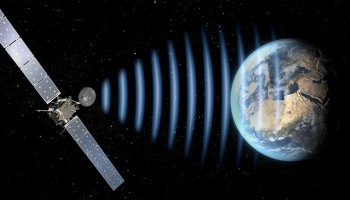
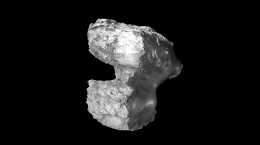
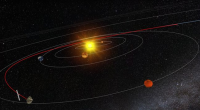
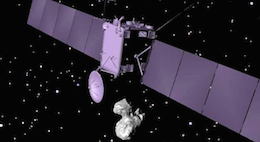

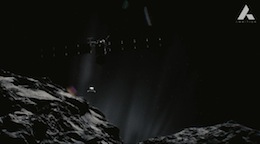
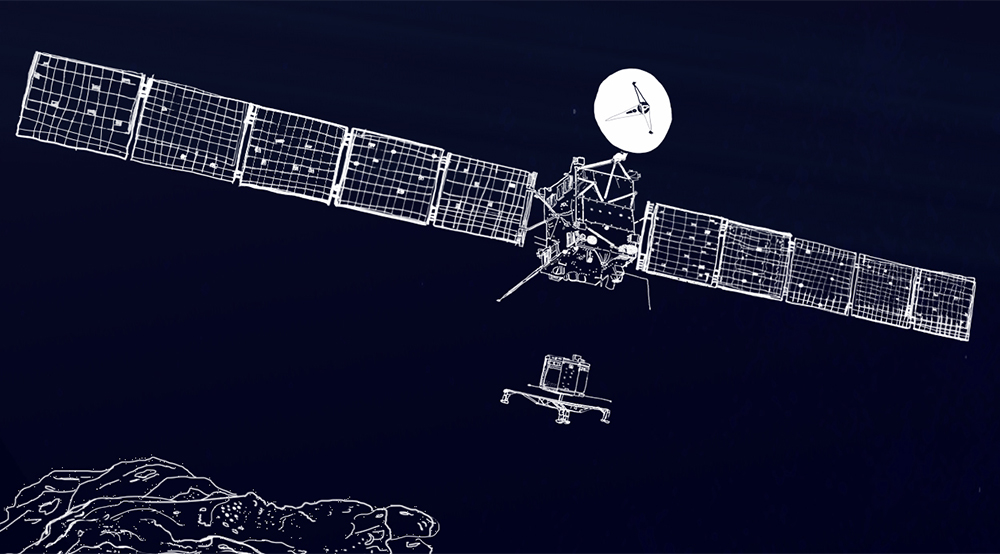
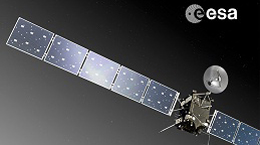
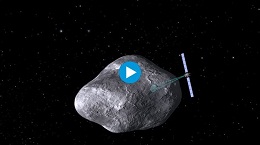
Discussion: 28 comments
This one increases the adrenaline level.
You mean the glycine level
The glycine ain’t the only thing rising
Firstly and above all, I’m so glad to hear the mission team succeeded to get Rosetta back online. I think I have understood that this is not a mission like one which just passes by its target with a safe distance from it. So I suspect the team might have “rehearsed” (again) what can happen in the last weeks of the mission. Might have been too dangerous, but now I’m sure the team will use this experience in the last weeks (and beyond on other missions!!).
Another very interesting news is the possible landing at near Agilkia. Looking forward to hear why someday soon. For visibility from Earth to maximize the possibility to contact Rosetta after landing?? Will it happen to be there by chance after trying to get maximum science return?? Or a romantic reason relating with Philae?? (which might give larger impact on public, especially kids who are the people who will explore on future missions, so it might make sense.)
Agilka has been chosen for Philae, since it’s smooth, compared to other areas.
And there is a more or less safe trajectory to Agilka.
For science reasons: If data, including images, can be sent during descent, we get a good comparison between pre- and post-perihelion.
Experience from Philae’s landing can go into Rosetta’s second attempt.
And if they could manage a successfull landing or rebound with a then still operational Rosetta…
I’m dreaming of an additional sample analysis from surface material.as an extra.
Originally I thought there was no chance at all of contact after impact – and that seems to be ESAs official position. The high gain antenna is very likely to be damaged, and certainly cannot be pointed at earth. The huge solar panels will also almost certainly be damaged, and can’t be pointed at the sun. They are very fragile things, designs for ‘zero g’ once deployed, minimum mass, not to survive impact.
But…..
There is isotropic antenna system that does not depend on pointing and does not have to point. That is likely to be less vulnerable to damage. And there are batteries.
So it seems *just possible*, if unlikely, that a low data rate link could survive for a while after impact/bounce.
However it’s not clear which instruments could still work and use the link. Not imaging, inadequate bandwidth and out of focus. Probably not anything using a boom. But just maybe one or two other instruments could deliver limited results, but the batteries are not that big.
If I remember correctly the last startracker incident was pre-perihelion around 2 AU from the Sun and 8 km from the surface. The present safe mode is at a little over 3 AU from the Sun (post-perihelion this time) and 5 km from the surface. With apologies to Sylvain and his team for the heartless question (I appreciate very much your work): would the next data point be around mid-July at 3.5 AU from the Sun, perhaps approaching 3.5 to 4 km from the surface? Is there reason to believe that there is a distance from the surface at which, all through its orbit, 67p has a large enough dust cover, to confuse startrackers at least?
“As usual with a safe mode…”!!!
🙂
A programmatic attitude spin dampening [against last known good inertial status] at 60s, ignoring loop output. Then at 4, 16… min. Until High Power Link responsive.
Can’t visualize now how cumulative attitude derive [error] could interfere with this approach, by now.
Or what would be the new risks…
Thinking on future designs, corner reflectors could provide loop data help from here.
If good enough for Moon on the 60’s, good enough for 67P today.
https://en.wikipedia.org/wiki/File:Corner_reflector.svg
https://en.wikipedia.org/wiki/Retroreflector#On_the_Moon
Thanks to Wikipedia & Wikimedia .Org & Contributors!
😀
Chassis core could be a radio corner reflector in itself. So, allowing use of the Earth Antennae tracker.
If devising some screen ‘shutter’ technology, then you have a terrestrial-based, emergency comm-link indifferent to spin & attitude [This one goes better with optical spectra reflectors] ;D
If devising some screen ‘shutter’ technology, then you have a terrestrial-based, emergency comm-link indifferent to attitude [This one goes better with optical spectra reflectors] ;D
Logan I’m not clear what you are trying to do. But don’t forget that a radio frequency corner cube is still subject to the laws of diffraction. It needs to be *far* bigger than the Apollo optical corner cubes, on the order of the size of the main high gain antenna dish.
Oops! You’re right, Harvey 😀
I still rate that there is maybe a 10% chance that the mission will change its mind and hibernate to end the mission rather than crash land. This is because the last useful thing that the probe can do is not taking images really close, but transmitting those images recently taken up close. Given the Earth-Sun-67P relative positions, this favours long elliptical orbits, with the distant part of the orbit most useful to be last.
Given an option to impact with the comet without possibility of a last minute image to confirm location, and no science possible in the act of performing this impact, the only sensible course of action is a last close pass filling the memory of Rosetta’s computers, and a hyperbolic trajectory escaping the gravity while as much of the data is transmitted back as possible, then hibernate with a shot in the dark wake-up sequence for future random possibilities in 2019 onwards.
Sadly, keeping Rosetta alive via hibernnation probably wont work. Let me explain:
1. The probes Hydrazine fuel is nearly depleted. If we were to keep in orbit any longer, it would run out of fuel and wont be able to point its dish at the Earth
2. It is unelikely that the probe will survive 3 more years in hibernation. Instruments are already showing sings of beeing close to failiure and some of the reaction wheels are dead.
3. Extending the Mission will cost a lot of money as you need to maintain the ground stations and teams although rosetta is in hibernation.
4. By trying to land on the comet, we can learn much more than by simply staying in orbit.
On that way, we can use the probe as efficient as possible before the end of its mission.
Hi AquilaLP,
Firstly, thank you so much for weighing in. I do have some responses (questions?) on each of the points.
1. Correct me if I am wrong – Rosetta doesn’t use any hydrazine fuel through hibernation. Any that may be left on hibernation will still be there if a future amateur mission tries to pull it out of hibernation.
2. Any probability that is not zero is what I am getting at here. It survived hibernation before, so there is a chance it may do so again.
3. I am not suggesting extending the mission. I am suggesting abandoning Rosetta presumed dead, but in a hibernated state – thus not costing any more than crash landing.
4. Due to the entirely non-interactive nature of guiding Rosetta to crash land, I cannot imagine any scientific benefit over close, but non impacting trajectories, that can have data relayed back as something that can be learned. We can only guess at the finished location of Rosetta anyway, as after impact we won’t know what happened (whether bouncing away, breaking up etc.) while we would for a close, non-impacting trajectory that we can receive information on the last gasp before abandoning the mission.
Marco: It seems possible that Rosetta cannot get closer to 67p than, say, 3 kilometres (see my post above) without deciding to go for a landing. So Rosetta will have to be at a distance, let us say 30 kilometres from 67p for it to be safest as well as gravitationally bound. Even such an orbit may not be stable (order of weeks or months) and requires some corrections now and then. Hence it seems to me that hibernation without fuel is not possible for a nucleus orbiter. Aimng for crashing into Jupiter, or the Sun, does not appear to yield valuable information. An interesting possibility is to aim for an asteroid or another Jupiter-family comet which has a path not too different from 67p. My guess is that requires more fuel than is available.
The best bet is a “stand-off” distance outside the hill sphere so at least 150 km or so away, probably more like 1000km away. Assuming an interested amateur group wants to load up the wake-up sequence in 3 years, Rosetta would have drifted in the order of 1 million kilometres from the nucleus. There would be only a reserve of between 0 to 10% Hydrazine left in the tanks, which would be end of mission safety margin to be able to complete ultimate manoeuvres. Relative velocity to 67P would be virtually zero, so a burn of the rest of the fuel to push Rosetta towards the nucleus for a possible flyby could be very plausible. A flyby would be invaluable,but enough fuel to park around 67P again at any distance under 1000 km would be a considerable payoff for the excercise at a negligible cost in terms of the Billion dollar asset that Rosetta represents.
Okay, Marco, got what you are saying: is it possible to make Rosetta not use fuel, move out of 67p’s orbit, and yet rendezvous with 67p a few years later, so as to wring the maximum mileage out of the mission. Interesting idea, but even if we ignore the additional costs mentioned by AquilaLP, not sure if the gravitational mechanics required can be pulled off.
HPC iteration could bring a model telling People on The Bridge what’s current spin and attitude status, simply from reflection data from antennae trackers.
This is huge task! Good Luck on this last one.
This HPC speculation is pure fantasy. 67P reflections will overload signal with noise.
Quite probably also natural corner reflectors on 67P lattice.
Why impact ? Why not try a bounce off the comet just like Philae did inadvertently of course?
Philae was designed to withstand a landing, and had ‘shock absorbing’ legs.
Rosetta has no such legs, and huge solar arrays and a high gain antenna (dish) which is extremely fragile. There are also fragile booms supporting instruments.
The chances of any of these surviving an impact are negligible..
There is a tiny possibility the low gain, low data rate antenna could survive and be battery powered for a short time, but I wouldn’t bet on it.
Well, to our EU parishioners: As near as could, until now:
” We therefore find that it is possible for planets to lose heavy ions to space entirely through electric forces in their ionospheres and such an “electric wind” must be considered when studying the evolution and potential habitability of any planet in any star system.”
Collinson, Frahm, Glocer & allies. GRLetters.
https://onlinelibrary.wiley.com/doi/10.1002/2016GL068327/full